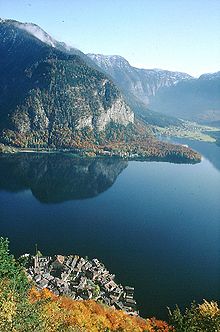Celtic bones

Celtic Bones is a novella by Wilhelm Raabe , written in the spring of 1864 and published in Westermann's illustrated monthly magazine that same year . The book edition was brought out by Hallberger in Stuttgart in 1869 as part of the “The Rainbow” collection. During Raabe's lifetime, reprints were published in 1871, 1896, 1901 and 1905.
The attempt of two North German scientists to steal museum treasures from the Celtic era from the Austrians fails in this grotesque because of the argumentative nature of the two well-off thieves.
content
In the spring of 1859 the narrator, a young German tourist, traveled to Austria. The war between Italy and Austria in Lombardy makes a detour to northern Italy seem risky. The narrator stays in Austria. From Vienna he visits Hallstatt via Ischl and Laufen . During this trip he made the acquaintance of three compatriots. The poet Krautworst from Hanover, he calls himself Roderich von der Leine, wins "dreadful verses" even from the day and night pouring rain in Hallstatt. This pathetic poetry is ruthlessly laughed at by Mr. Zuckriegel, prosector at a small north German university. Zuckriegel never misses an opportunity to mess with the hotel staff and their three German fellow travelers. In Mr. Steinbüchse, professor of antiquity from Berlin, Zuckriegel has found an equal contender. The nervous poet Krautworst can soon no longer bear the bitter, hour-long arguments between the two scholars. The stubborn bickers are united by one goal. Both want to steal antiquities from the Rudolfsturm Museum - located high above Hallstatt . The treasures are to be brought to Northern Germany. While Steinbüchse is out for grave goods , Zuckriegel wants to steal Celtic bones.
The narrator takes part in the osteological excursion of the two unscrupulous scholars and even declares himself willing to assist. The young man is supposed to distract the dearest doorkeeper in the museum with a long kiss. It doesn't come to that. The two uncontrolled academic predators cannot wait for the right moment and fall upon the treasures from the Iron Age at the first opportunity . In the heat of the battle, Steinbüchse steals the bones and candy bars the grave goods. The “scientific corpse robbers” flee heavily packed. The young guard calls for help. The narrator is arrested as a "suspicious bourgeoisie" of the two thieves. Austrians who are familiar with the area immediately chase the two German robbers storming down the valley.
Steinbüchse throws away one of the loot on the run. Zuckriegel can't believe it. This "vile Berliner" gets rid of "his" Celtic skull. Furious, Zuckriegel draws level. A sword, a “silly cheese knife”, flies into the bushes on the escape route. Revenge follows revenge. The two academics arrive down in Hallstatt empty-handed. The inspector up at the museum is satisfied. Every stolen piece was brought back to him by the nimble pursuers. He can quietly patch his Celts back together and let the narrator run.
reception
Raabe processed experiences from an educational trip from 1859. The prehistoric burial ground, part of the Hallstatt culture, was only described scientifically enough after 1864. In the figure of the poet Krautworst, Raabe mocked his own "past lyrical period".
Meyen names two reviews. For example, Heinrich Blume goes into Zuckriegel's travel reading in 1936: " Avé-Lallemant : Das deutsche Gaunertum ".
expenditure
First edition
- The Rainbow. Seven stories by Wilhelm Raabe. Hallberger, Stuttgart 1869. Vol. 1 contains The Hämelschen children. Else von der Fir. Celtic bones. Saint Thomas
Used edition
- Celtic bones . Pp. 199-240. With an appendix, written by Karl Hoppe and Hans Plischke, pp. 474–487 in Karl Hoppe (arrangement), Hans Oppermann (arrangement), Hans Plischke (arrangement): Erzählungen. The last right . A funeral oration from 1609 . Elderflower . The Haemel children . Else von der Fir . Celtic bones. Three feathers . Vandenhoeck & Ruprecht, Göttingen 1974. Vol. 9.1 (2nd edition, obtained by Karl Hoppe and Rosemarie Schillemeit), ISBN 3-525-20118-4 in Hoppe (ed.), Jost Schillemeit (ed.), Hans Oppermann ( Ed.), Kurt Schreinert (Ed.): Wilhelm Raabe. Complete Works. Braunschweig edition . 24 vols.
literature
- Hans Oppermann : Wilhelm Raabe. Rowohlt, Reinbek bei Hamburg 1970 (1988 edition), ISBN 3-499-50165-1 (rowohlt's monographs)
- Fritz Meyen : Wilhelm Raabe. Bibliography. 438 pages. Vandenhoeck & Ruprecht, Göttingen 1973 (2nd edition). Supplementary volume 1, ISBN 3-525-20144-3 in Karl Hoppe (Ed.): Wilhelm Raabe. Complete Works. Braunschweig edition . 24 vols.
- Cecilia von Studnitz : Wilhelm Raabe. Writer. A biography. 346 pages. Droste Verlag, Düsseldorf 1989, ISBN 3-7700-0778-6
- Werner Fuld : Wilhelm Raabe. A biography. 383 pages. Hanser, Munich 1993 (dtv edition in July 2006), ISBN 3-423-34324-9 .
annotation
- ↑ Volume 9.1 contains a misprint on page 232, 12. Zvo.
